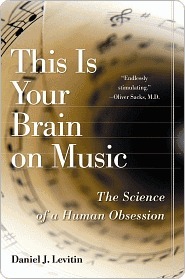More on this book
Community
Kindle Notes & Highlights
Read between
January 12 - February 6, 2025
In “Lady Madonna,” the four Beatles sing into their cupped hands during an instrumental break and we swear that there are saxophones playing,
Babies may see the number five as red, taste cheddar cheeses in D-flat, and smell roses in triangles.
(The research on the development of the first MRI scanners was performed by the British company EMI, financed in large part from their profits on Beatles records. “I Want to Hold Your Hand” might well have been titled “I Want to Scan Your Brain.”
When we say of a model that she is photogenic, we’re talking about how this star quality manifests itself in photographs. The same thing is true for musicians, and how their quality comes across on records—I call this phonogenic.
Phonogenic. A useful word, and possibly first used here. If not yet used elsewhere, it should be,,and I shall try to do do myself.
As Internet radio and personal music players are becoming more popular, I think that we will be seeing personalized music stations in the next few years, in which everyone can have his or her own personal radio station, controlled by computer algorithms that play us a
Musical instruments are among the oldest human-made artifacts we have found. The Slovenian bone flute, dated at fifty thousand years ago, which was made from the femur of a now-extinct European bear, is a prime example. Music predates agriculture in the history of our species.
Music is no doubt older than the fifty-thousand-year-old bone flute, because flutes were unlikely the first instruments. Various percussion instruments, including drums, shakers, and rattles were likely to have been in use for thousands of years before flutes—
A third argument in favor of music’s primacy in human (and proto-human) evolution is that music evolved because it promoted cognitive development. Music may be the activity that prepared our pre-human ancestors for speech communication and for the very cognitive, representational flexibility necessary to become humans.
Cosmides and Tooby argue that music’s function in the developing child is to help prepare its mind for a number of complex cognitive and social activities, exercising the brain so that it will be ready for the demands placed on it by language and social interaction.
As a tool for activation of specific thoughts, music is not as good as language. As a tool for arousing feelings and emotions, music is better than language. The combination of the two—as best exemplified in a love song—is the best courtship display of all.
*Deaner, R. O., and C. L. Nunn. 1999. How quickly do brains catch up with bodies? A comparative method for detecting evolutionary lag. Proceedings of Biological Sciences 266 (1420):687–694. A recent scholarly article on the topic of evolutionary lag, the notion that our bodies and minds are at present equipped to deal with the world and living conditions as they were fifty thousand years ago, due to the amount of time it takes for adaptations to become encoded in the human genome.


